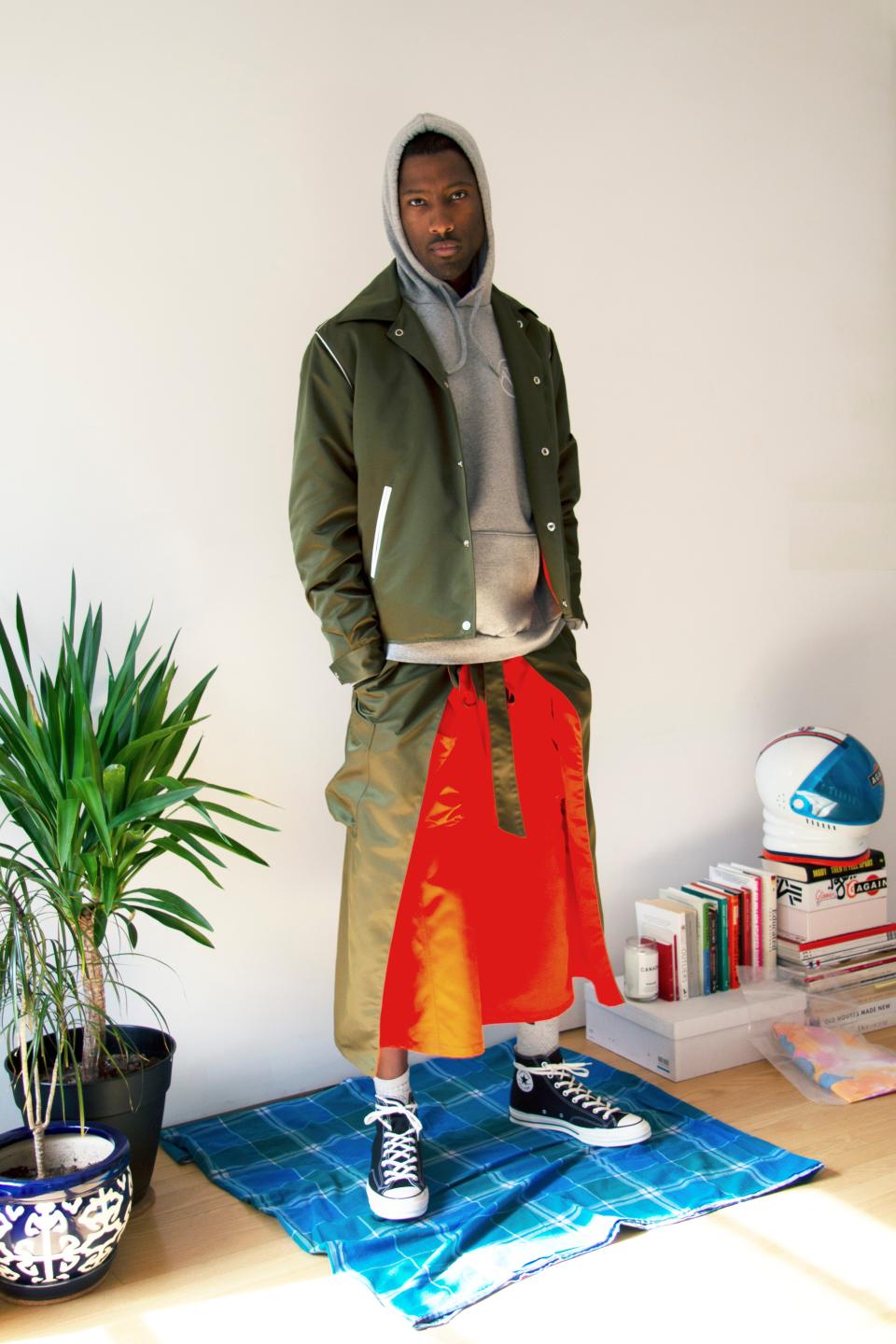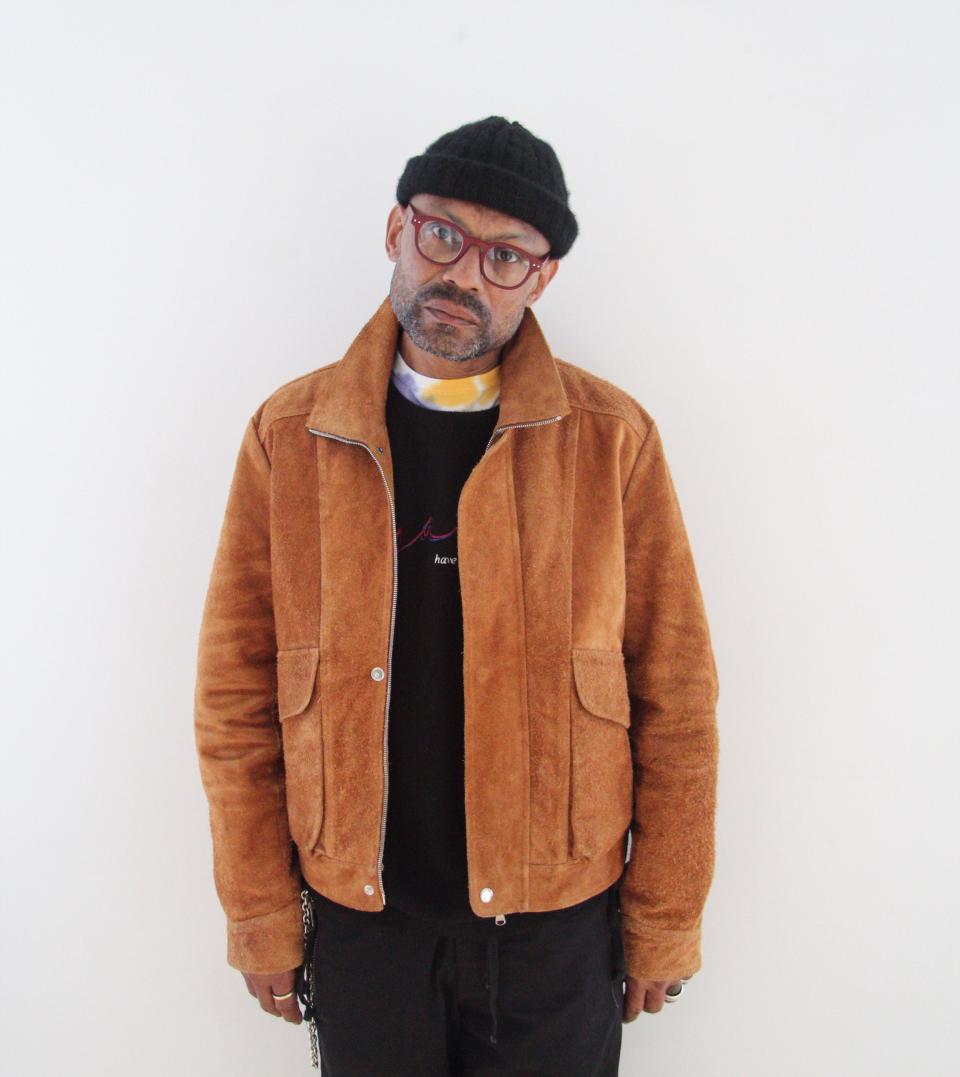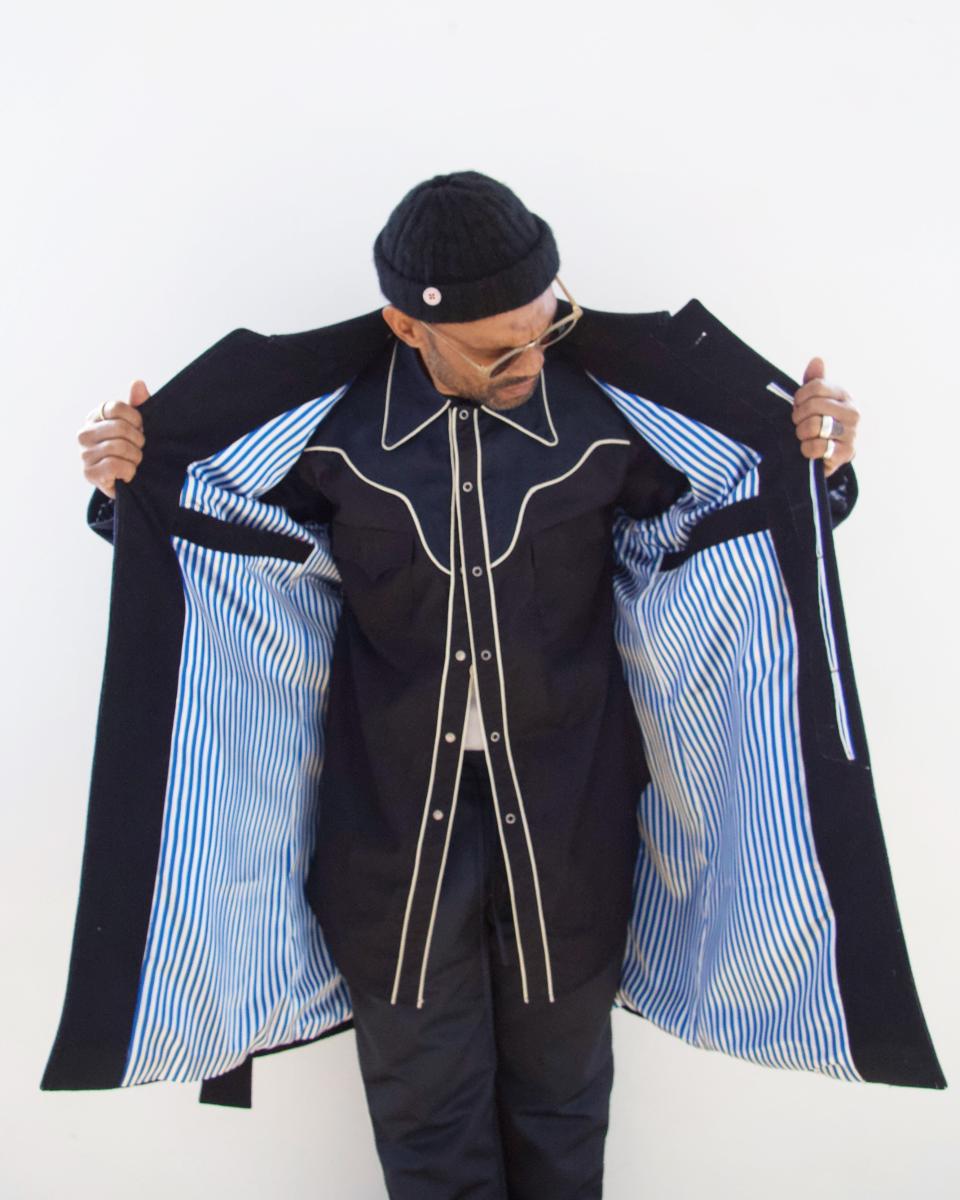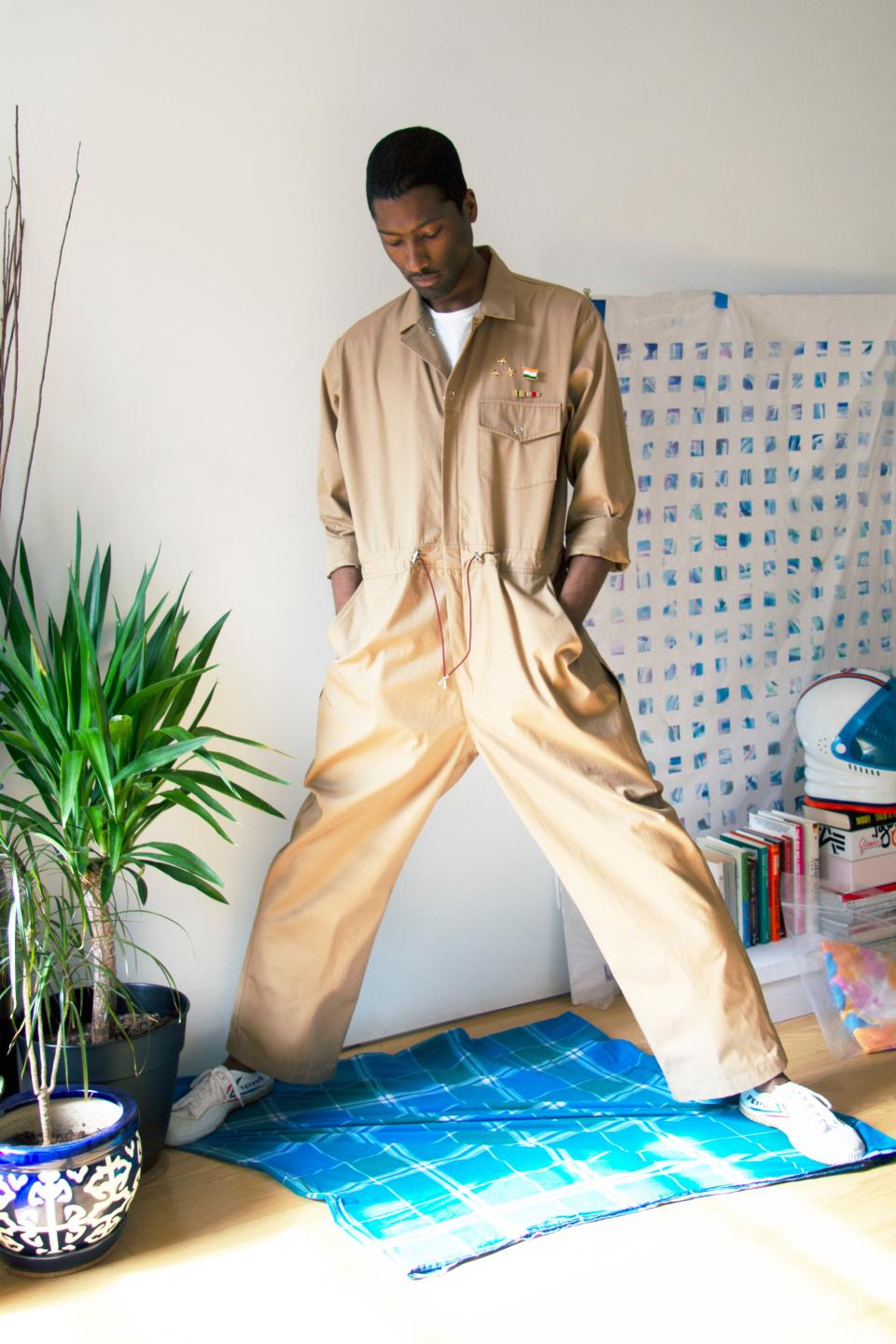What Does a “New York Brand” Look Like in 2020?
Last summer, a few weeks after Mayan Rajendran had showed me his first set of releases for Again&Again, his new New York-based-and-produced clothing line, a funny thing happened. Among the grip of his just-off-center, deeply Manhattan-feeling pieces, one had stuck out: a snap-button cowboy shirt, black with white piping and blue overlay on the shoulders, the front of the garment drooping lower than the rear. Rajendran explained that the shirttails were cut extra-long so you could tie them up, Daisy Duke-style, to sit at your beltline. I snickered internally. Who’d wear their shirt like that? And then the funny thing: GQ’s October issue dropped, and with it a photo of cover star Brad Pitt strolling into frame. His pink shirttails were expertly, daintily tied at his belt.
Coincidence? Maybe! But again&again is premised on the idea that it might not be—that you can take the whispered-about lessons from a career in and around the fashion business and package them into a clothing line. Rajendran seems ideally placed to make that bet. His fashion career started at The News, the showroom that introduced a generation of would-be menswear obsessives to brands like Common Projects, and then moved to M5, another if-you-know-you-know showroom (and creative agency, and party brigade).
He booted up Again&Again a little more than a year ago, first as a multipurpose creative agency, and then as a dedicated clothing line. The goods, he told me when we spoke again in late February, come from a practical concern. He’s been operating out of his Manhattan apartment, and has one question constantly top of mind: “How much closet space can you really have in New York?” So the collection is made up of almost-essentials—that cowboy shirt, sweats cut like trousers, a killer suede jacket—that are designed to pull double (or triple, or quadruple) duty. The whole thing, he said, is about “having something your girl wants to steal.” Newer pieces, like a tan jumpsuit and a bomber jacket-inspired “cargo sarong,” and new made-to-order options, like jacket liners made from his Indian relatives’ heirlooms, reflect a different, heritage-minded impulse. “They are my mix of memories of being an Indian growing up in Canada while watching American media,” he wrote me this week, as the pandemic put his work on hold.
Now, like the rest of us, he’s holed up at home but still fulfilling orders online. Before the world turned upside down, we met over at his place, picked up lunch from an Indian deli around the corner, and sat down to talk about his path to opening up a made-in-New York business. Starting, oddly enough, with the decision to quit that showroom job, move to Frankfurt, and pick up work interning for the art director of Stone Island, the culty Italian label.
This conversation has been edited and condensed.
GQ: So, at 31, you're like, I'm going to go be an intern for a little bit.
Mayan Rajendran: Yeah. It was a tough decision to make. I have a personal life here, and career, but I just knew that I wanted to plant my foot forward my way. So I did that.
What were you hoping to get out of that? Or what did you get?
I want to refine some of my skills and be back within a workplace where that was their main thing. That was the main focus of the business. It was great to be around like a multifaceted agency, but simultaneously I wanted to have more focus so that I could polish up the skills I've learned over the years. So I did that, came back here, opened up my own company, which is like a freelance creative consulting agency. And then I started the brand in December [2018].

This is the first time you’ve actually put out clothing, right?
Under the brand name, this is my first release. But in the past, with the guys at M5, we would throw parties and we would make clothes and T-shirts.That was my first little bit of experience trying to get people to wear stuff that they want to keep for a long time. But this is my first season under the title.
And so what were you looking to do? What was the goal?
I went into it with a very heavy sales mentality. I did Paris, I tried to show in New York. That market is not easy to get through—it takes a lot of investment and a lot of facetime with people and being out and about. I'm an independent designer. I'm not trying to get money, I'm trying to do this on my own and sustain it over a period of time. So now I look at it as a sketchbook that just doesn't end. So every time I have an idea that pertains to the brand, I'll just make it and release it. I thought it was going to be this big thing I wanted to grow, but now I just want to be able to do it again.
We talked a little bit about this last time I was here, but are there some pieces that feel most representative of what you're trying to do?
I think the tie-dye pieces are a really clear message of what I think Americana is today. The feelings, the colors, even down to where it's being produced. I'm trying to do everything here in New York. And the leather jacket. That leather jacket, I really tried to make it iconic, as best I could. Like how can I see Steven McQueen wearing it? But then how can I see someone in our current society wearing it, too?

So let's talk about that, in terms of specific design decisions. When you say "iconic,” that's a high bar to set, right?
I try to look at it in a way where it becomes something, through a personal lens. Can I wear it? Can my father wear it? Can my father lend it to my mom when she's feeling cold? And does she still feel good in it? So there is a lot of testing that goes with each piece, with the sampling and the fabrics and the liner and the cut. But I feel comfortable enough to be at a place by the end of it where the people that do like it, they love it.
Those pants with that split up the hem—I'm curious what the thinking is there.
That was something I wanted to make for the trip you're taking to the airport, and for then the function that you're going to once you land. I am by no means someone globetrotting to galas. Many of us may not be that person, but we're in this day and age where luxury is for everyone. And really, in this city is the only place that that's actually possible. New York is that place where you could be at an art opening and then at a party and then at your boss's whatever. So you want to have something that is malleable to all situations. I wanted to take some design cues from traditional pants, and so I took the jogger, with the way that the elastic band is normally at the bottom of the pant, and did my iteration of it, with two functional slits. I wanted it to be something that you could wear with a loafer or with a sneaker.
There’s a funny thing about starting something by yourself: you're designing it, so you're the primary creative voice. You're saying "Hey, I think this is a good idea. Are you guys in? I think you might like this." I bet that can be a hard place to put yourself.
It is a lot of pitching and I think the biggest challenge I faced was feeling confident in my own decisions. It does come with time and it does come with experience, but you have to learn how to make decisions quicker and feel more confident in them and not beat yourself up after. So yeah, when you pitch, you really you leave your ego at the door. And you just hope that all the factors line up for you. Some people will get it, some people won't. Some people are having a bad day when you're doing it.

You said you're not forecasting six or eight months or a season or two ahead, but you’re also saying, "I want to be in this for the long haul." What does that kind of planning look like? Are there ideas or goals or plans or timelines?
So the way I'm looking at it is: do the profits from these two things justify the costs to make the third thing? And literally just having it flip into the next, into the next, into the next. I do enjoy doing this by myself. It's a lot of work. It's stressful. But this is also very personal to me. I hand-package everything, write notes. I like that aspect of it. I also like setting that kind of pace for the way a business has grown because I don't want to take the joy out of that and have someone else package it for me.
You're from Toronto; you've got more global roots. You've settled here, and you've been in Frankfurt. I wonder how the geography filters into the work you're doing. In other words: is this a New York thing?
This is very much a New York brand. Because this is where my adulthood has been shaped.
To my mind, a New York brand, it's got an attitude, right? It's not necessarily like a "fuck you" attitude, but there's a little bit of salt to it, a little bit of sandpaper. It's stuff that you could wear to an art opening, and it's stuff you could wear to a party, and it's stuff you could wear to a fancy dinner. Your girlfriend has tickets to the opera or something, there's a little bit of that, too: worldliness but super local.
I think the thing that makes my brand feel New York the most is that it's really flexible for all different aspects of your life. You can't really nail down and define a New Yorker the way you used to. Because people come from all different lots, no one stays the same.
And, was the intention early on always to produce locally as much as possible? Or does that come up as you start thinking about how this is going to happen?
It started coming up as I began to think about the really big decisions of production. I came here with that How to Make It in America dream.

Originally Appeared on GQ

